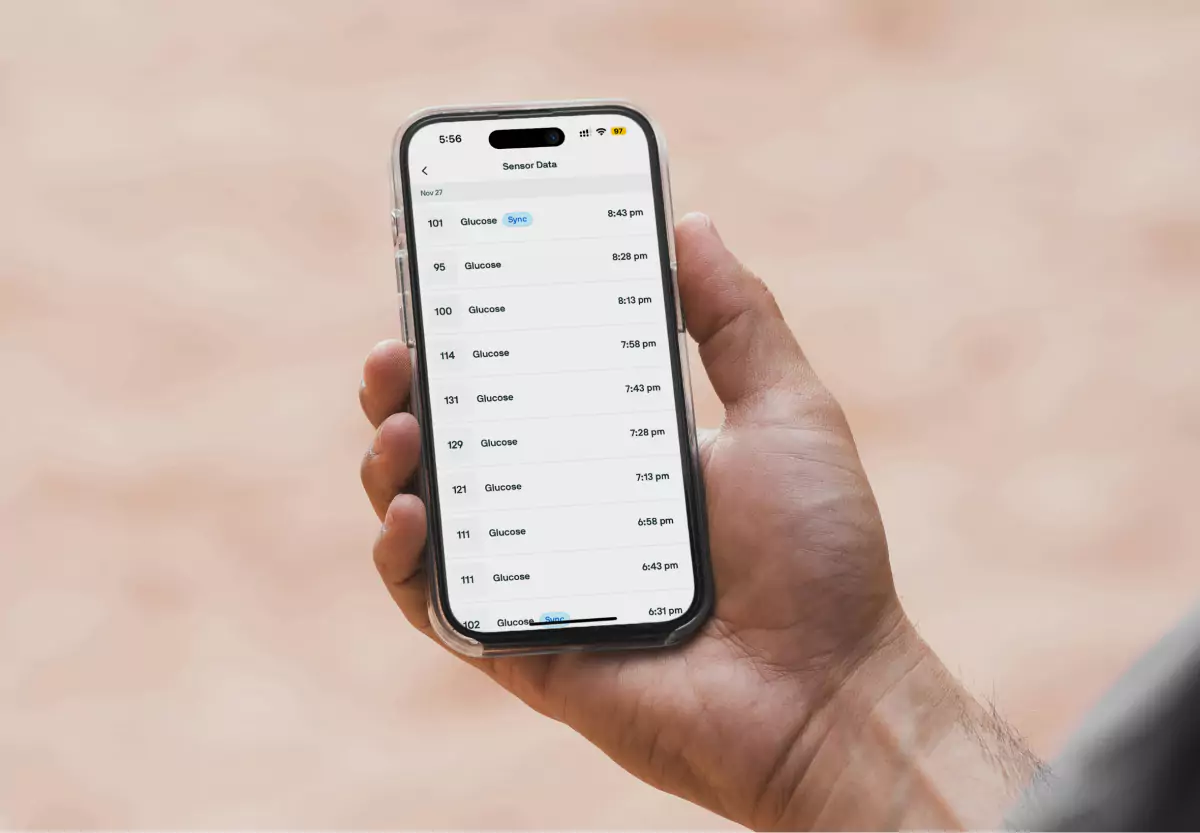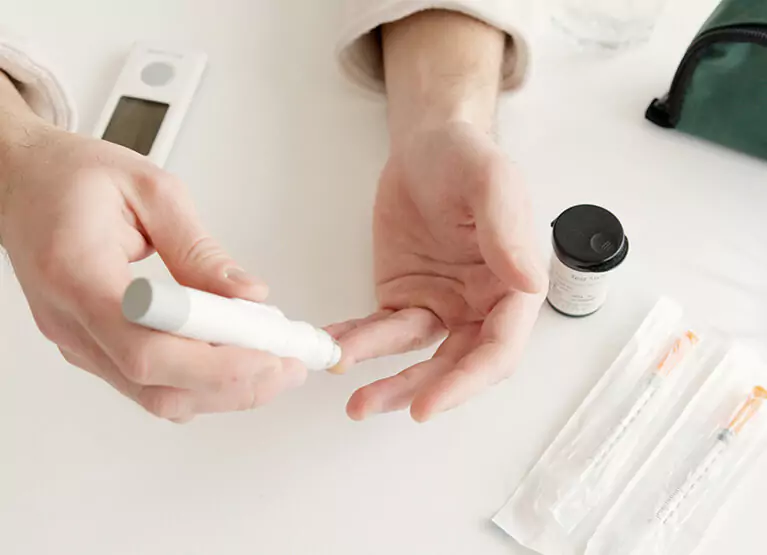How to Read a Blood Sugar Log
.webp)
Key Takeways
There are many benefits to regularly testing your blood sugar levels. Monitoring your levels can also be used to optimize your metabolic health and can even help with weight loss.
There are a few different ways to accurately track your blood sugar levels, which fluctuate throughout the day based on diet, activity levels, and other lifestyle factors. A blood glucose meter (BGM), also commonly referred to as a glucometer, measures the whole blood to obtain a reading. It has traditionally been used to get an immediate reading on your blood sugar at the time of the test.
In contrast, glucose biosensors and continuous glucose monitors, or CGMs, measure blood sugar via interstitial fluid using a small device that is inserted onto the back of the upper arm. One of the many benefits of the CGM or glucose biosensor is that it captures glucose readings 24/7.
Regardless of the method you choose to test your blood sugar levels or glucose levels, finding a way to track them over time and measure any significant changes is a great way to stay on top of your health.
Let’s explore what a blood sugar log is and how keeping one may help you to better understand the factors that affect your overall health.
What is a Blood Sugar Log?

A blood sugar log is a place where you record your blood sugar levels during specific times throughout the day. They’re commonly used among individuals with type 1 or type 2 diabetes, but can also be helpful for anyone monitoring the factors that lead to blood sugar spikes and dips.
In your blood sugar log, you’ll record your blood sugar levels before and after eating, and you can also make a note of other factors that might influence significant spikes. These factors can include things like carb intake, stress levels, supplements, medicines, and certain health conditions.
A blood sugar log can be formatted depending on your preference, but many people use apps or templates that you can download online.
Regardless of the format you choose, remember that you’ll need to measure your blood glucose levels at similar times (fasting level, post-meal). Consistently using the same measurement unit (either mg/dL or mmol/L) is also helpful to make future comparisons easier.
Why is a Blood Sugar Log Important?
Keeping a blood sugar log allows you to see how your blood glucose levels have changed week over week, month over month, or even year over year. With a log that tracks your levels over time, you can determine if they're trending in a favorable or unfavorable direction.
A blood sugar log can also help you reflect on your current lifestyle and dietary choices to try to pinpoint what is positively or negatively affecting your blood sugar. Factors such as a sedentary lifestyle, high stress levels, or a nutrient-poor diet can all contribute to negative trends, for example.
Tracking your blood sugar may also help you be able to connect the dots between poor glucose levels and associated symptoms. It can also support you in incorporating healthier dietary or lifestyle habits to improve your blood sugar levels and view your progress.
Keeping track of your blood glucose can be even more important if you’re someone with diabetes or if you’re at risk for developing this condition.
What is the Normal Range for Blood Sugar?

Glucose levels rise and fall throughout the day based on foods eaten, stress levels, exercise, and even sleep, which is why tracking the factors that have the greatest impact on your blood sugar can be helpful.
However, it’s important to consider that normal blood sugar levels vary based on factors such as age, so the normal range may vary for children and the elderly.
For adults without diabetes, fasting blood glucose levels between 70 to 90 mg/dL are considered to be the normal range. Individuals with chronically high fasting blood glucose levels may be at higher risk of developing prediabetes or type 2 diabetes.
The Nutrisense Nutrition Team generally recommends daily average glucose of <105 mg/dL for a healthy adult. It’s also recommended to avoid repeated spikes of >140 mg/dL to reduce the risk of other adverse health effects.
Types of Blood Sugar Logs
Although each person can decide which type of formatting and measurement units they prefer to use, there are four main blood sugar logs that are commonly used for tracking.
You can choose the format that makes the most sense for monitoring your glucose levels based on your health goals.
Weekly Blood Sugar Logs

True to its name, a weekly blood sugar log is a record of your blood glucose levels (measured either in mmol/L or mg/dL) every week.
Ideally, you should aim to measure your blood glucose at the same times each day (after meals) and keep this up throughout the week if you’re testing manually (using a BGM).
If you’re using a CGM or glucose biosensor, you can simply access the data for the same time each week and record that information in your blood sugar log.
Weekly Blood Sugar + Insulin Log
A blood sugar and insulin log is similar to a blood sugar log, except that it’s also used to keep track of your insulin dosage. This is helpful for individuals with type 1 diabetes (or sometimes type 2 diabetes).
With this log, you can track the dosage of insulin you administer and how it affects your blood sugar. Including insulin dosage can also be helpful for monitoring insulin resistance, as you can get your insulin levels tested and track how your blood sugar levels adapt over time.
Insulin levels can be tested either by measuring fasting insulin levels or through the oral glucose tolerance test (also called the glucose tolerance insulin response). The Nutrisense Nutrition Team uses and recommends the GTIR.
Monthly Blood Sugar Log

Similarly to a weekly log, a monthly blood sugar log is a record of your blood glucose levels each day throughout the month. You can use this format to record blood sugar changes after meals and add any relevant comments about the reading.This method of tracking is commonly used among people who are tracking their blood sugar less frequently, but help you see the bigger picture when it comes to your blood glucose.
Basic Blood Sugar Log
A basic blood sugar log is the simplest format used to keep track of your blood sugar over a period of time. This type of log allows you to record the date, time, and blood sugar value for a specific reading, and you can also include an additional column for notes or additional comments.This format may be helpful for anyone just starting out with tracking their levels, or for someone looking for more general insights.
Best Practices for Reading a Blood Sugar Log

- Ensure that you measure and record blood glucose levels in the same measurement units.
- Record your blood sugar at the same time and day each time (if possible).
- Remember to measure glucose values before a meal and then again two hours after your meal.
- Look at weekly or monthly patterns rather than daily values to see the bigger picture and detect general trends.
- Understand what a normal or optimal blood sugar value is for you by consulting a medical professional. Keeping a goal in mind can help you gain a better understanding of how effective your current approach is.
Find the right Nutrisense programto turn insight into progress.
Go Beyond Glucose Data with Nutrisense
Your glucose can significantly impact how your body feels and functions. That’s why stable levels are an important factor in supporting overall wellbeing. But viewing glucose isn't enough. Nutrisense, you’ll be able to learn how to use your body's data to make informed lifestyle choices that support healthy living.
One-to-one coaching
Sign up to access insurance-covered video calls to work with a glucose expert: a personal registered dietitian or certified nutritionist who will help tailor your lifestyle and diet to your goals.
Monitor and measure what matters
With the Nutrisense CGM Program, you can monitor your glucose with health tech like glucose biosensors and continuous glucose monitor (CGM)s, and analyze the trends over time with the Nutrisense App. This will help you make the most informed choices about the foods you consume and their impact on your health.
Find your best fit
Ready to take the first step? Start with our quiz to find the right Nutrisense program to help you take control.

Amanda is a Nutrition Manager and Registered Dietitian, with a Masters in Dietetics from Stephen F. Austin State University. Originally from south GA, she got her undergrad degree from Texas Tech University. She worked at a hospital in Fort Worth, TX, for 4 years as a dietitian, counseling those living with HIV.




